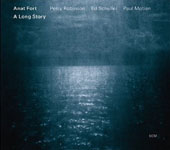Home » Jazz Articles » Live Review » Andrea Centazzo and the Ictus Renaissance Project at the...
Andrea Centazzo and the Ictus Renaissance Project at the Rubin Museum
Rubin Museum of Art, 150 West 17th Street
New York City, New York
Friday, March 9, 2007. 7:00 PM
The Rubin Museum of Art first opened its doors on October 4, 2004, dedicating itself to the art and culture of the Himalayas and the surrounding regions. This spring, a program called Harlem in the Himalayas presents jazz at the museum.
Percussionist Andrea Centazzo, whose Ictus Records label recently released the highly acclaimed 30th Anniversary Collection, is embarking on an Ictus Renaissance Project of which Soul In The Mist, co-produced with Konnex Records and due out in a few weeks, is the result.
The music for the first half of the program comprised compositions represented on this recording, performed in the spacious, comfortable and visually impressive downstairs space at the museum. Centazzo's percussion set fit right into the performance space since it is made up of open drums of different sizes and three cymbal towers that look like pagodas, making for a visual spectacle. On his left, he also had a computer tied to some other percussion instruments. The vibe of Ictus Records includes a variety of Japanese themes on the covers, so as a venue the Rubin seemed apropos.
Joined by pianist Nobu Stowe and Perry Robinson on clarinet and micro-ocarina, Centazzo's music shimmered and hung before us from the stage. Robinson was in front of the group, while Stowe was behind on the left, requiring him to read Robinson's body language for musical cues. Stowe also kept in close contact with Centazzo.
Music like this is hard to characterize or label. Many of the phrases and lines Robinson played were strongly tonal while a few pieces had a drone-like quality. What was notated and what was improvised was virtually impossible to ascertain, but the music always had a forward energy which developed and mutated as the piece progressed. Whatever else that can be said about it, the music was very emotional and quite uplifting.
Centazzo uses his percussion as another musical voice, and both his drums and cymbals were pitched. Playing his set both in and out of time, as percussive sound and also rhythm, the artist was continually in motion.
On the second half of the concert, the trio was joined by tabla player Badal Roy, who has played with Miles Davis and John McLaughlin. His presence almost seemed unplanned, and he talked a bit about the nature and vocabulary of tabla, the nature of the tuned drums and the transformation of sentences that he hears in his mind into musical statements.
Joking that he was no tabla master, Roy gave a short "class" on tabla, demonstrating how to do things he said no "real" tabla player would do. He was very free and lively, putting his total self into his playing. The groove he established was mesmerizing, providing a startling contrast with the previous music of the tuned drums. Indian music, to my ears, always has elements of the sensuous and the meditative or mystical. The music of the first half also had those elements but expressed in a different way.
Quite an evening.
Visit Andrea Centazzo, Badal Roy and Nobu Stowe on the web.
Tags
PREVIOUS / NEXT
Support All About Jazz
 All About Jazz has been a pillar of jazz since 1995, championing it as an art form and, more importantly, supporting the musicians who make it. Our enduring commitment has made "AAJ" one of the most culturally important websites of its kind, read by hundreds of thousands of fans, musicians and industry figures every month.
All About Jazz has been a pillar of jazz since 1995, championing it as an art form and, more importantly, supporting the musicians who make it. Our enduring commitment has made "AAJ" one of the most culturally important websites of its kind, read by hundreds of thousands of fans, musicians and industry figures every month.





















